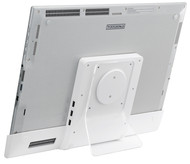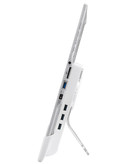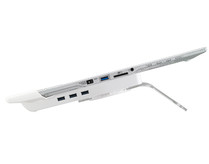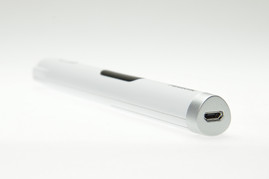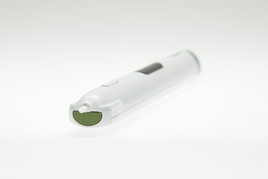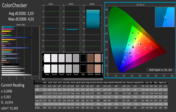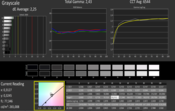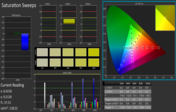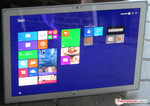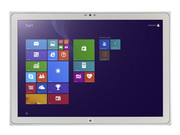Panasonic Toughpad UT-MB5 Tablet Review

For the original German review, see here.
The Panasonic Toughpad UT-MB5 is definitely not a tablet for normal home users, whose primary goal is surfing the web while relaxing on the couch. Rather, Panasonic targets photographers, marketing executives, and sales representatives - in other words, professionals who need to work with graphics and pictures. In order to support the demanding CAD operations and 3D modeling, the Toughpad UT-MB6 comes equipped with a dedicated Nvidia Quadro K1000M GPU.
A search in our database did not reveal any direct competitors, since the Toughpad is a fairly specialized niche product. Only the Sony Vaio Tab 20 is also equipped with a 20-inch display, but of course this tablet targets a different group of users.
Case & Connectivity
Panasonic calls the UT-MB5 a "Business Ruggedized Tablet PC". It is reasonable to expect that the tablet is more robust and more durable, although the device does not comply with any standardized protection ratings - at least Panasonic makes no claims that it does. The case is made out of plastic. The back and the outer edge of the front panel are made of transparent plastic with gray lines running through diagonally. Underneath these transparent gray lines, another layer with a much finer pattern is visible. The bezel is silver-gray; the back features rubber feet so putting the tablet down safely is possible. The tablet is sturdy and the construction quality without faults. The UT-MB5 is basically very rigid and as sturdy as Panasonic claims it to be.
The back of the tablet is attached with screws and can be removed to allow access to the hardware. The RAM module (DDR3) could be removed and swapped out with an 8 GB module and the mSATA SSD is replaceable as well.
Panasonic has equipped their tablet with the bare minimum of interface ports. A plus is the full-sized (not micro or mini) USB 3.0 port. The optional docking station features three USB 3.0 ports, HDMI out, Ethernet and the power connector, but it is far from cheap at 400 Euros ($510). We would have liked to use the docking station for our tests, because it got a little cumbersome after a while having the large tablet flat on the desk.
Input Devices
The large touchscreen recognizes up to 10 fingers and our review unit worked flawlessly. The Windows virtual keyboard is easy to operate thanks to the large screen size. The primary input device is the Electronic Touch Pen, which Panasonic includes free of charge. The pen connects via Bluetooth, is pressure sensitive and supports up to 2048 pressure levels. The handwriting recognition included with Windows worked without a problem, but to utilize the full potential of the pen, more appropriate and specialized software is needed. A small display shows the battery charge level and the connection status. The included USB charging cable is long enough to allow the user to operate the stylus while it is charging.
For those who are interested in using a normal keyboard and/or a mouse once in a while: we were able to successfully connect a PS/2 keyboard and mouse with the aid of a PS/2 to the USB adapter.
Display
The Toughpad features a 20-inch display with a native resolution of 3840x2560 pixels. We found the aspect ratio of 3:2 (or 15:10) quite appropriate for the tablet and easy to work with, as a Din-A3 (US: tabloid or ledger) page fits more or less perfectly. We would like to see this aspect ratio used more frequently for notebooks and monitors in general - in our opinion the extremely common widescreen ratio of 16:9 does not work for all usage scenarios. The average brightness of 231 cd/m² is not great, but still works well for the intended application. However, both the contrast ratio (761:1) and black value (0.33 cd/m²) are quite decent. Since it is assumed that users will operate the tablet mostly indoors, the values we measured are certainly acceptable.
| |||||||||||||||||||||||||
Brightness Distribution: 77 %
Center on Battery: 251 cd/m²
Contrast: 761:1 (Black: 0.33 cd/m²)
ΔE ColorChecker Calman: 2.03 | ∀{0.5-29.43 Ø4.79}
ΔE Greyscale Calman: 2.25 | ∀{0.09-98 Ø5}
Gamma: 2.43
CCT: 6544 K
The display produces balanced and very vivid colors. The DeltaE-2000 deviation of 2.03 (values below 3 are considered good) confirms our initial positive impressions. The panel also does not suffer from a bluish cast, which is so often an issue. Unfortunately, we cannot comment on the coverage of the professional color spaces AdobeRGB and sRGB, since our measuring software kept on crashing.
Panasonic uses an IPS panel for the Toughpad and consequently, even very shallow viewing angles are possible. Unfortunately, the display is highly reflective, which makes using the tablet outdoors very difficult. But as mentioned above, the UT-MB5 was designed for indoor use. Apart from the size, the weight, and the glossy panel, the power consumption of the tablet also restricts how far the user can venture away from power outlets.
Performance
Panasonic targets photographers, architects, marketing executives, and sales representatives. A Core i5 CPU and GeForce GPU provide the necessary processing power. At a price of 4500 Euros ($5800), the UT-MB5 is not likely to appeal to the average home user.
Processor
The tablet is equipped with an Intel Core i5-3437U processor. It is rather surprising that Panasonic decided to use an Ivy Bridge CPU even though Haswell CPUs had been available for a couple of months when the tablet was released at the end of 2013. The Core i5 CPU is clocked at 1.9 GHz, although Turbo Boost can increase both cores to 2.7 GHz or a single core to 2.9 GHz when needed. Intel specifies a TDP of 17 Watts. Full processing power is available, whether the tablet is plugged into mains or running on battery power. During the Cinebench benchmark tests, both cores operated at their maximum of 2.7 GHz; during the single-thread test, one or the other core would occasionally jump to 2.9 GHz.
System Performance
Thanks to the powerful processor and the fast Solid State Disk, Panasonic's tablet is speedy and performs well. Windows boots quickly, and the results of the PC Mark benchmark tests are also quite decent, although a look at the comparison table shows that the Toughpad is slightly slower than other devices. Two reasons: the tablet has a less powerful CPU, and it does not make use of the integrated Intel GPU. The PC Mark benchmark test utilizes all available GPUs - and since the Toughpad only has the GeForce graphics card, it does not do quite so well here.
| PCMark 8 Home Score Accelerated v2 | 2191 points | |
| PCMark 8 Creative Score Accelerated v2 | 2099 points | |
| PCMark 8 Work Score Accelerated v2 | 2963 points | |
Help | ||
| PCMark 8 - Work Score Accelerated v2 (sort by value) | |
| Panasonic Toughpad UT-MB5 | |
| Asus X750LN-TY012H | |
| Toshiba Satellite Pro C70-B-111 | |
| HP ProBook 470 G1 E9Y75EA | |
Storage Devices
The UT-MB5 comes equipped with a 256 GB mSATA Solid State Disk from Samsung. The SSD is quite fast, but does not score well enough to deserve a top spot in our database. The write speeds, especially, lag behind other drives in this category.
| Panasonic Toughpad UT-MB5 GeForce GT 745M, 3437U, Samsung PM851 Series MZMTE256HMHP | Lenovo Miix 2 11 HD Graphics 4200, 4012Y, Samsung SSD PM841 MZMTD128HAFV mSATA | Schenker XMG P724 GeForce GTX 880M SLI, 4810MQ, Samsung SSD 840 EVO 500GB mSATA | Schenker XMG P704 GeForce GTX 880M, 4910MQ, Crucial M500 480 GB CT480M500SSD3 mSATA | Nexoc G728II GeForce GTX 860M, 4700MQ, Mushkin Atlas mSATA MKNSSDAT240GB | |
|---|---|---|---|---|---|
| AS SSD | 4% | 74% | 54% | -29% | |
| Seq Read (MB/s) | 504 | 496.5 -1% | 504 0% | 482.2 -4% | 198.9 -61% |
| Seq Write (MB/s) | 254.6 | 113.4 -55% | 483.6 90% | 385.3 51% | 152.6 -40% |
| 4K Read (MB/s) | 18.81 | 25.12 34% | 40.83 117% | 26.52 41% | 17.57 -7% |
| 4K Write (MB/s) | 33.43 | 63.5 90% | 109.9 229% | 114.9 244% | 102.9 208% |
| 4K-64 Read (MB/s) | 361.7 | 182.5 -50% | 355.2 -2% | 319.2 -12% | 96.6 -73% |
| 4K-64 Write (MB/s) | 183.4 | 92.3 -50% | 270.5 47% | 255.7 39% | 137.9 -25% |
| Access Time Read * (ms) | 0.207 | 0.131 37% | 0.097 53% | 0.114 45% | 0.154 26% |
| Access Time Write * (ms) | 0.074 | 0.054 27% | 0.03 59% | 0.053 28% | 0.266 -259% |
* ... smaller is better
GPU Performance
Although the Toughpad is equipped with an integrated GPU courtesy of its Intel processor, only Nvidia's GeForce GT 745M graphics card is actually active and the Intel GPU is turned off. The GT 745 is a middle-class GPU, which supports DirectX 11 and operates at a nominal frequency of 680 MHz, although the Turbo can increase the core to 941 MHz if needed. The 3D Mark benchmark tests show that other devices with the same GPU generally produce better results. The reason is the comparatively low Turbo speed of the GeForce GPU in the Toughpad.
| 3DMark 11 Performance | 2016 points | |
| 3DMark Ice Storm Standard Score | 36854 points | |
| 3DMark Cloud Gate Standard Score | 5169 points | |
| 3DMark Fire Strike Score | 1219 points | |
Help | ||
| 3DMark 11 - 1280x720 Performance (sort by value) | |
| Panasonic Toughpad UT-MB5 | |
| Sony Vaio Tap 20 SVJ2021V1E | |
| HP ZBook 17 E9X11AA-ABA | |
| HP ProBook 470 G1 E9Y75EA | |
| Toshiba Satellite Pro C70-B-111 | |
| Medion Akoya S6215T-MD98549 | |
| Asus X750LN-TY012H | |
Gaming Performance
Both the CPU and the GPU are powerful enough to handle most current games in HD resolution with the quality set to medium. Of course, the tablet was not designed for playing games, which can at times lead to problems. Because the resolution is set at 3840x2560 pixels, this is the only resolution available within the games. Some games, of course, offer other resolution settings when they are started in windows mode, but even then, some common ones are simply missing. Case in point: we could not select 1366x768 when playing Tomb Raider. Out of curiosity, we ran the integrated benchmark of Grid Autosport with the native 4k resolution at both low and medium settings, which resulted in frame rates of 38.8 and 14.7 fps, respectively.
| low | med. | high | ultra | |
|---|---|---|---|---|
| Tomb Raider (2013) | 107.8 | 14.8 |
| Tomb Raider - 1024x768 Low Preset (sort by value) | |
| Panasonic Toughpad UT-MB5 | |
| Sony Vaio Tap 20 SVJ2021V1E | |
| HP ZBook 17 E9X11AA-ABA | |
| Toshiba Satellite Pro C70-B-111 | |
| Asus X750LN-TY012H | |
Emissions
System Noise
Owners of the Toughpad have to get used to the fact that the fan is always on - and always audible. Users can influence the behavior somewhat, as a tool located in the system tray allows the user to pick between standard, low speed, and high speed settings. Subjectively, we could not really see a big difference between the settings.
Noise level
| Idle |
| 34.8 / 35.2 / 40.8 dB(A) |
| Load |
| 41.2 / 42 dB(A) |
 | ||
30 dB silent 40 dB(A) audible 50 dB(A) loud |
||
min: | ||
Temperature
During the stress test, the case temperatures reached 50 degrees C (~122 °F) in some places. Considering the hardware, the temperatures are certainly within an acceptable range. Panasonic uses two fans to cool the UT-MB5. The stress test did not run for very long, however: after a few minutes, the tablet locked up. This behavior is reproducible with every subsequent attempt leading to the same outcome, so we cannot really make any long-term predictions. Before the tablet froze, the GPU maintained a speed of 941 MHz. The CPU ran at full speed only during the first minute before dropping down to 1.3 - 1.7 GHz
(-) The maximum temperature on the upper side is 49.1 °C / 120 F, compared to the average of 33.7 °C / 93 F, ranging from 20.7 to 53.2 °C for the class Tablet.
(-) The bottom heats up to a maximum of 50.8 °C / 123 F, compared to the average of 33.2 °C / 92 F
(±) In idle usage, the average temperature for the upper side is 35.8 °C / 96 F, compared to the device average of 30 °C / 86 F.
Speakers
The stereo speakers are located on the back and produce a thin and tinny sound. For better sound quality, we recommend connecting external speakers or headphones using the headphone jack.
Energy Management
Power Consumption
Even while idling, the Toughpad draws up to 34.6 Watts. The culprits here are the high-resolution display, and the fact that the Intel GPU is turned off. Under load, the power requirements exceed 70 Watts, although medium load levels (3D Mark 06) require more power than full load (stress test with Prime95 and FurMark), since the latter scenario induces CPU throttling. The power adapter supplies 110 Watts and can easily handle the load.
| Off / Standby | |
| Idle | |
| Load |
|
Key:
min: | |
Battery Life
Our battery tests are not particularly well suited considering the tablet's intended use. We still decided to run our WLAN test, during which a script cycles through various websites every 40 seconds. For this test, the power savings profile is active and the screen brightness is set to approximately 150 nits. Because of its rather small battery with a capacity of 34 Wh, the Toughpad shut down after only 1 hour and 11 minutes. Panasonic promises run times of up to 3.5 hours, but we suspect that accomplishing this feat not only requires selecting one of the numerous pre-installed energy saving profiles, but also for the screen brightness to be reduced even further.
Verdict
Panasonic's 20-inch Toughpad UT-MB5 tablet has no issues handling the tasks and duties it was designed for. The sturdy tablet is far from inexpensive, as it is a specialized niche product serving an even smaller segment of the market than workstations do. The standout feature is the 20-inch display with its 3:2 aspect ratio, which simply cannot be found elsewhere. The picture is balanced and very pleasant.
We like the ease of maintenance, as the back of the tablet can be removed to access the hardware components. Panasonic is a bit stingy as far as the configuration is concerned. For 4500 Euros ($5800), we would expect more than only 4 GB of RAM and a 256 GB SSD. The fan is always on and gets annoying after a while, and the power consumption is quite high. We can only hope that Panasonic will upgrade to the next CPU and GPU generations during the next refresh. Our experience with Maxwell graphics cards like the GeForce 840M is very positive - especially as far as power consumption, temperatures, and battery life are concerned.








